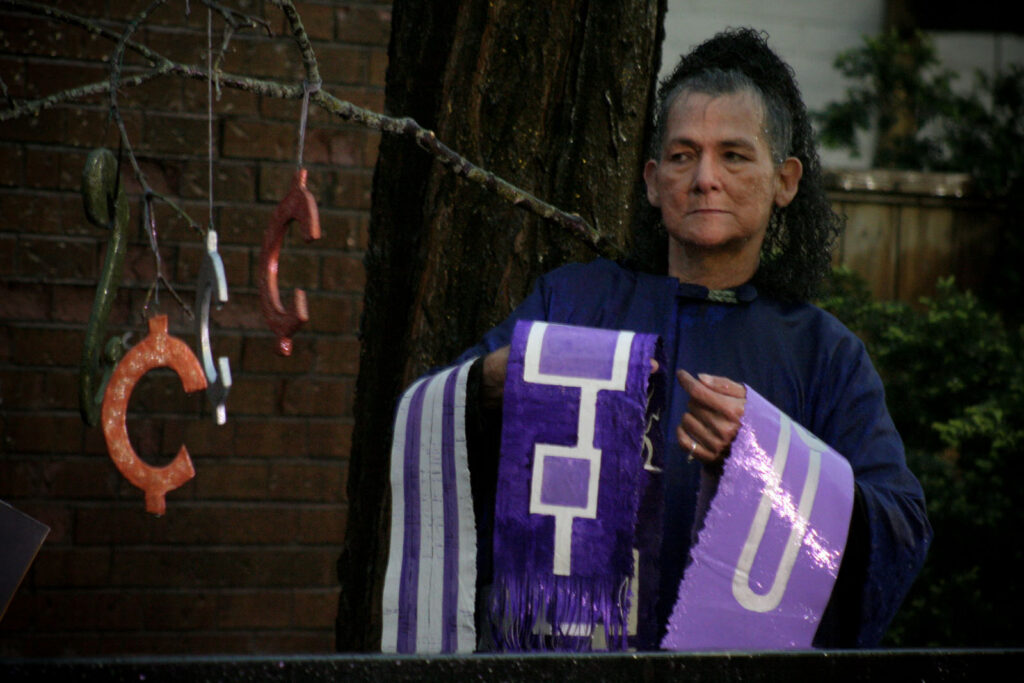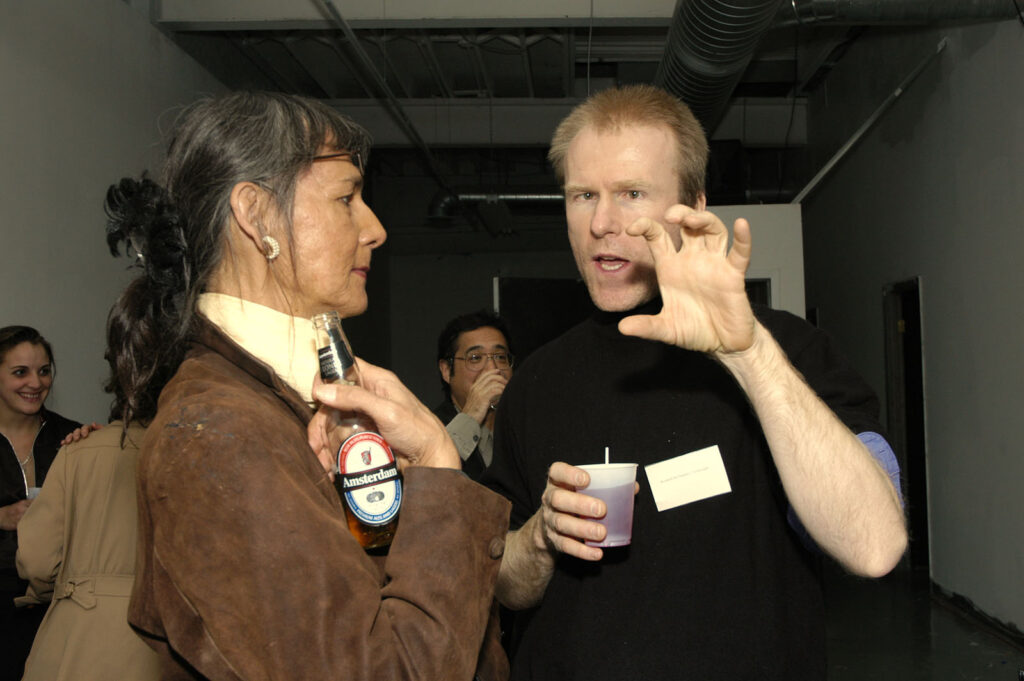By Paul Couillard

Aiyyana Maracle | November 25, 1950 — April 24, 2016
Aiyyana Maracle was a fierce soul with a gentle but powerful voice. In “A Journey in Gender,” an article published in torquere,[1] Aiyyana described herself as “a transformed woman who loves women,” her way of steering readers toward a decolonized understanding of her gender and sexuality.[2] In the article, she argues for an Indigenous perspective of a multiplicity of gender identifications, suggesting that in most traditional Indigenous cultures, those whose gender fell outside the strict confines of a male/female binary were recognized as both socially and spiritually integral to their culture, valued for their unique insights. She writes, “We were healers, people of medicine, we were storytellers, seers and visionaries, artists and artisans—we were among the keepers of the culture.”[3] Aiyyana was both a keeper and a maker of culture, asserting her own voice and place within contemporary North America through her art practice, and facilitating the voices of others through her curatorial, directorial and activist roles and projects.
Aiyyana was her own unique story-crafter and storyteller, in ways that give me pause as I seek to honour her by sharing my own memories of her. I am aware of the vigilance with which she scrutinized all stories’ ability to redistribute power. The life she claimed as an Indigenous, transformed woman often required her to negotiate a contradictory and confrontational path, where her many triumphs, accolades and accomplishments were weighed against a stinging set of rebukes, exclusions and adversities. Viewing her journey from outside—telling my own story of her story—what strikes me is her remarkable ability to repeatedly adapt, transform and create new circumstances to nurture a dynamic but ever-deepening and hard-won personal sense of authenticity. She was, as one of her friends described her, “a warrior in a skirt.”[4]
Aiyyana framed her various transformations in relation to an ongoing process of decolonization. Born a “boy” on Six Nations territory in southern Ontario, Aiyyana grew up in the urban settings of Rochester and Buffalo, because her parents were forced off reserve when her father was not recognized as a status Indian. Her parents worked hard to assimilate themselves and their children into a Eurocentric and Christian culture—which Aiyyana came to understand as a very practical survival strategy—but, in her own words, “the whispers from the Grandmothers told me who we were, and I resisted that [assimilation] mightily.”[5] Similar whispers eventually also supported her transition from male (after having fathered and raised multiple children through two marriages) to female in the early ’90s.
I first met Aiyyana holding court—there really is no better description for it—at the kitchen table of grunt Gallery in Vancouver, where she played an integral part in nurturing a burgeoning contemporary native art scene. She struck me then as a strong woman very much in her element, exerting her influence and contributing to the development of a vibrant, evolving community in a myriad of both subtle and strident ways. She was generous yet uncompromising, forceful but also vulnerable. Years later, I remember meeting with her at her apartment, where she gave me a careful look up and down before pronouncing that she trusted me enough to allow me to produce her work. By posing the possibility of a working relationship in this admittedly imperious manner, she was making clear that for her, producing performance art was no casual matter of simply providing entertainment or furthering career goals: it was a sacred passion that should only be entrusted to thoughtful and respectful contexts.
I was eventually responsible for producing two iterations of a performance Aiyyana titled ndn wars are alive, and … well? The first version was presented as part of FADO’s IDea series in Toronto’s Trinity Bellwoods Park in 2006 in the context of the 7a*11d International Festival of Performance Art. The work had two key components. First, a looped documentary videotape, compiled by Aiyyana Maracle with La Mathilde, chronicled the troubled relationship between the Crown and Canada’s Indigenous populations, pointing to the ongoing resistance to a colonial, settler occupation that most non-Indigenous Canadians imagine to be simply a matter of historical record. For the Toronto version, the videotape was projected large onto the grassy slope of a hill, and on a smaller scale, onto the side of a white tent erected on the grounds. The second element was Aiyyana’s presence. Appearing in various animal masks, Aiyyana manifested a shadowy figure against the night backdrop, a trickster presence darting among the trees or silhouetted on the ridge of the hill. Eventually, Aiyyana appeared as a human figure and began a slow spiral dance across a large section of ground. Although Toronto was not a traditional Mohawk territory, this slow, careful choreography offered a pointed assertion of Indigenous presence on contested land. Ethereal, almost ghostly, the image of Aiyyana stepping and sounding left a lasting imprint. Certainly this occupation was symbolic, metaphorical, but it was also undeniably material: an Indigenous body claiming both a physical territory and a cultural space of ritual in a location thought to be fully governed and policed by (post?)colonial infrastructures. The image she created has always had ambiguous resonances for me. Looking through one set of eyes, I see a lonely, ephemeral figure conjured up out of a cold, windswept night, like a ghost of a past that never quite existed. At the same time, I also feel a powerful medicine, an insistence that as long as even one figure can persist in calling up this dance, in renewing a claim of resistance, the questions of dominance and territory that haunt our country remain unsettled and demand renegotiation. The playful appearance of the masked figures leaves a lingering sense of exhilaration; the sombre, determined dancer, a sense of dignified sobriety.
The second version of this performance was presented outside Gallery Lambton (now moved and renamed the Judith & Norman ALIX Art Gallery) in Sarnia in 2010 as part of a performance event called Present Response. This piece was staged quite differently, presented from the early evening to dusk of a gloomy, occasionally rainy spring day. The video was again prominent, projected onto a brick wall behind the artist, slowly becoming visible as the sky darkened, and also playing on a monitor installed to one side of the outdoor tableau. Aiyyana’s presence was confined to a narrow patch of sod temporarily laid down in a fenced-off area beside the walkway leading up to the gallery. Dotting the grass were rows of miniature flags, sporting symbols of the Six Nations. Over the course of the three-hour performance, these flags were decimated by a white male figure sporting a weed whacker while Aiyyana, an imposing, silent presence dressed in a colourful robe, stood her ground at the far end of the space. Sarnia, traditionally Chippewa territory, is no less marked by colonial possession than Toronto. In this version of Aiyyana’s ndn wars…, what we have come to see as the ‘normal’ status of an ordinary urban space—the entrance to a gallery and a shopping mall, part of the downtown geography of a long-established Canadian city—was reconfigured to reveal another part of its human history, to bear witness to an ownership status that, however widely accepted and normalized, remains contested. And if only the faintest traces of the projection could be detected against the backdrop of Aiyyana’s body and the brick wall beside her, does this not also speak to the underlying question—of what we are able to see of what is, even if invisible, nevertheless there?
By the time Aiyyana presented the first version of the work in 2006, she had left Vancouver and taken up an unpaid position as a Visiting Scholar at McGill University in Montreal. In 2010, when she presented the second version, she had returned to the Six Nations reservation where she had been born, on the Grand River near Ohsweken in southern Ontario. Each of these moves required a corresponding reinvention of her self-image. Neither of these transitions was easy, and she struggled with both financial and mental health challenges. Despite these adversities, she managed to cultivate close familial and community ties, living with one of her sons and becoming an important advocate for trans and gender nonconforming youth. She became the co-facilitator of Gender Journey, a peer support group run out of the Grand River Community Health Centre. She was also a proud great-grandmother several times over. Respectful of the capital-G Grandmothers who oversaw her journey, she also brought a deep sense of commitment and sensitivity to her own role as a grandmother and elder. Commenting on the role she found herself inhabiting in this period of her life, she reflected, “There is no mirror for who I am. From necessity I became the mirror for all the younger ones.”[6]
Aiyyana’s adaptability and resilience reflected her understanding that we as humans, and the cultures we create, are always evolving. In her own words—words she not only wrote but also found ways to embody and live by—
For people and culture to survive, they need to evolve continually. What we as Indigenous people need to do is scrape off the stagnated scum from the culture in which we presently find ourselves immersed, pick up the residue of our historic cultures, and reblend the cultural pattern of who we really are today by following the roots inherent in the laws, values, and principles embodied in the old ways. This we need to do so that our grandchildren may find their way through to tomorrow with their humanity intact.[7]
—Paul COUILLARD
[1] This now-defunct scholarly journal was published in the late 1990s and early 2000s by the Canadian Lesbian and Gay Studies Association / Société Canadienne des études Lesbiennes et Gaies. For more information, see http://torquere.journals.yorku.ca/index.php/torquere/index.
[2] Maracle, Aiyyana, “A Journey in Gender,” torquere 2 (2000): 36-57, p. 36. http://torquere.journals.yorku.ca/index.php/torquere/article/view/36587/33238
[3] Ibid., p. 41.
[4] Ibid., p. 55.
[5] Interview on Tranzister Radio 29, CKUT 90.3 FM, October 9, 2014. https://drive.google.com/file/d/0B0KGgCD3_zjTMjVXT2ZvM1J0VnM
[6] Colleen Toms, “Six Nations woman shares her transgender experience,” Brant News, January 19, 2015. http://www.brantnews.com/news-story/5264793-six-nations-woman-shares-her-transgender-experience/
[7] “A Journey in Gender,” p. 49.

Aiyyana Maracle was a multidisciplinary artist, scholar and educator, sovereign Haudenosaunee woman and great-grandma many times over. She spent a half-century actively infusing Ogwehoweh art and culture into the Eurocentric consciousness of Canadian society. A powerful activist and advocate on many fronts, her work dealt with a range of issues, from indigenous land claims to trans identity. Through performance art, video, theatre (where she was awarded the prestigious John Hirsch Prize for emerging theatre directors in 1997), writing, and lecturing, Aiyyana offered an alternate framework to the prevalent Eurocentric view of ‘gender dysphoria,’ eventually becoming a voice and activist for young trans or gender nonconforming individuals on Six Nations reserve on the Grand River.
Aiyyana was featured in the 6th 7a*11d International Festival of Performance Art in 2006. Her piece, ndn wars are alive, and … well? was presented as part of the FADO series IDea at Trinity Bellwoods Park.
